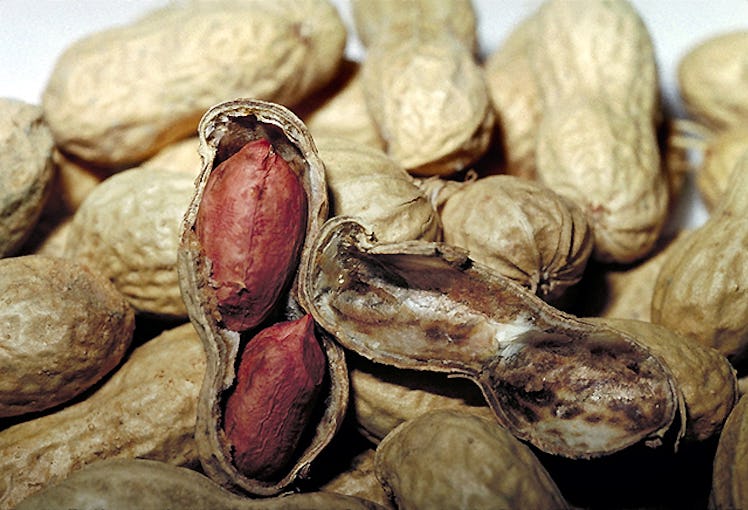Peanut Allergies Are About to Become a Thing of the Past
The FDA recently approved the first treatment for peanut allergies. More are on their way. Here's what that means for parents.

Earlier this year, the Food and Drug Administration approved the first treatment for peanut allergies. The drug, called Palforzia, doesn’t cure peanut allergies, but it does build resistance against them. Many think this will be a game-changer for millions of families. But it’s not alone. From peanut patches to liquid drops, researchers have been hard at work looking for peanut allergy cures since 2017, when the FDA approved the health claim that early introduction of peanuts to infants helps prevent peanut allergies. The solutions are rounding the corner and it looks like 2021 could promise to be the year that peanut allergies became a thing to defeat, not live with.Children with peanut allergies live in a careful bubble. Depending on the child, even the tiniest taste can cause anaphylactic shock. Up until this year, no treatments were available, so all parents could do was try to keep peanuts away from their kid and always have an EpiPen on hand. “For so long, we had nothing to offer these patients,” Pamela Guerrerio, chief of food allergy research at the National Institutes of Health, told the Associated Press. “We finally have a treatment. That’s a big step.”
First FDA-Approved Peanut Allergy Treatment
Children aged four to 17 can start taking Palforzia, which comes as a powder made from defatted peanut flour. The drug is first administered at a low dose that is increased 10 times over six months. The allergic child must take every increased dose at a health center certified with a special safety program. They also take a maintenance dose every day at home, mixed into semi-solid food like pudding or applesauce.Two-thirds of children who take Palforzia are able to safely eat the equivalent of two peanuts, and some are able to eat three or four, according to a study of nearly 500 kids. However, children may have to continue eating the protein powder every day to stay desensitized. “This should be treated like a daily multivitamin — something that becomes routine to administer at home every single day,” Jonathan Spergel, a Palforzia researcher and chief of the allergy program at the Children’s Hospital of Philadelphia, told
Medscape.Nearly all of the children in the study experienced minor side effects such as itchy mouth, and 20 percent had severe side effects such as vomiting that led them to drop out. This treatment is clearly not for everybody.
Up-And-Coming Peanut Allergy Treatments
One potential alternative to Palforzia is a peanut patch that goes directly on the skin. The patch, called Viaskin, exposes immune cells in the skin to peanut allergens to build up resistance. Viaskin isn’t approved by the FDA yet, but experts think the treatment is promising. One study found that 52 percent of kids who used the patch could tolerate three or four peanuts without an allergic reaction. The patch probably doesn’t build as much resistance as Palforzia, but it likely causes less side effects, according to the American College of Allergy, Asthma, & Immunology
.Researchers at the Food Allergy Initiative at North Carolina University are testing a liquid peanut solution that goes under the tongue and is also designed to build resistance. The liquid drops, which are equivalent to about 1/150 of a peanut, must be held under the tongue for several minutes before swallowing. They must also be taken every day. One small study of 48 children found that after three to five years, nearly 70 percent of the participants were able to eat two and a half peanuts without an allergic reaction. Wesley Burks, the director of the Food Allergy Initiative at University of North Carolina, says that the drops are more effective than the patch with less side effects than the peanut powder.Stanford University is trying another approach that doesn’t use peanuts at all: an antibody shot.
In a pilot study with 20 adult participants, researchers found that an antibody shot allowed 73 percent of those who received the treatment to eat the equivalent of one peanut two weeks after injection. The protection lasted for up to six weeks. Researchers aren’t studying injecting peanut protein itself because exposure to peanuts via injection is more likely to cause a severe allergic reaction than exposure through the mouth or skin.“What all of us hope for that would be truly revolutionary is a treatment that’s curative, that really gets rid of the food allergy permanently,” Hemant Sharma, director of the Food Allergy Program at Children’s National, told the Associated Press. But for now, only one approved treatment is available, and evidence suggests that all the proposed treatments will need to be taken for life.
This article was originally published on